another night at mugaritz

“Satiation eludes bread and olives...” Bromas y aceitunas, pocas o ninguna.
'What have you come [to Mugaritz] for? You haven't come here to eat. You've come to take a risk, to unleash all your senses and let them wander at will along unmarked paths full of stimuli, surprises and dangers.''
That's Andoni Luis Aduriz, talking about his restaurant Mugaritz, the number three in the world.
I'm pretty much a number one fan of this place (post after post to prove it). And last month I had the occasion to return for a meal that I was sure couldn't top last spring's. Well....
To my pleasant surprise, the 'submit' and 'rebel' envelopes were gone, and they were replaced with another envelope, with a new and improved EDIBLE letter, accompanied ever so thoughtfully by an olive cream for spreading. Yes! Talk about setting the tone for a meal.
Then, in what has become one of my favorite Spanish anecdotes, our lovely waiters delicately reminded us that there would be NO BREAD for the first couple amuse/courses. Oh, PHEW, because without the warning there may have been a restaurant-wide revolt a la the French Revolution.
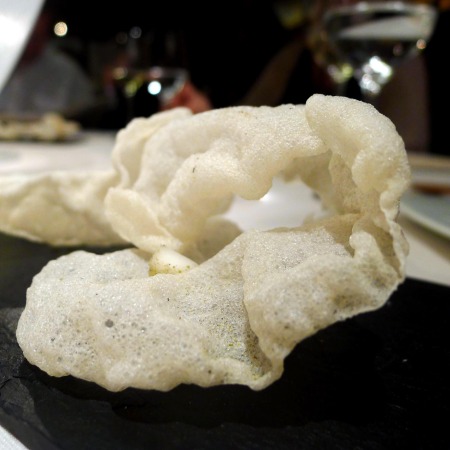
Crunchy sauce with citron and peppers. Salsa crujiente con cidra y pimientas.
What followed was a flexing of muscle of sorts by one of the world's best chefs. You thought sauce was liquid? Wrong...liquid on your tongue, but not on the plate.

Tempered white asparagus and chrysanthemum petals. Esparrago blanco sobre un gel de mariscos tostados y brotes de "alga de tierra".
You thought white asparagus had to be cooked or jarred? Well, just forget everything you thought you knew about asparagus.
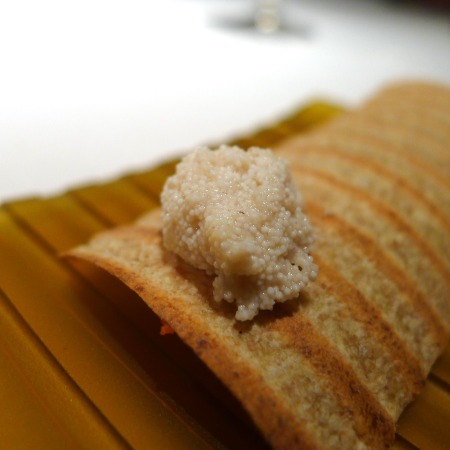
Flax and wheat “Kraft” paper with roe and Arrow-grass buttons. Papel “Kraft” de lino y trigo con huevas de besugo y semillas de junco marino.
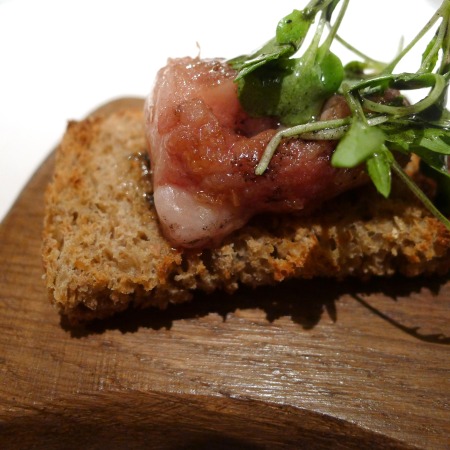
Grilled toast of bone marrow with herbs and horseradish ash. Tosta con tuétano asado, hierbas y cenizas de rábano.
Then a plate I *freaked* about.

Stimulating insipidity: crunchy morsel of salted roe. Huevas de besugo con guisantes lagrimas.
These are raw guisantes de lagrima, or tear peas. They are tiny, costly, and labor intensive at the hour of gathering. But they are truly nature's caviar. They pop pleasantly when you chew them, releasing an aroma of dirt, fields, and greens. The roe served as the seasoning. Just total luxury.

Slices of foie-gras cured in clay and Sichuan peppercorns. Bath of apple extract. Láminas de fuagrás curado en arcilla y pimientas de Sechuan, bañadas con un extracto de manzana.
Then more luxury. Foie, floating in a clarified apple juice made from local apples. I love that behind each dish lies so much technique.
Now, at this point we were pulled back into the kitchen. After speaking a bit to one of the chefs, we were handed a cookie to taste. Then the chef said, "Guess what's in this. It's three ingredients." *SPOILER ALERT*
I said, "Blue cheese." Because you could just tell. Yep.
Then silence. "It's sweet," offered the chef. And someone said sugar. Yep.
Then, a lot of silence. "You'll never guess it," he laughed. BLOOD. Blood was the third ingredient in this beautiful, dainty macaron. !!! On the menu it reads:
The belly button of a monk...Blue cheese and black pudding Macaron. Macaron "ombligo de monje".

Then, the only dish to be repeated on this year's menu, the mortar and the pestle broth. This night, however, every table received it at the same time, and you could hear the clinking, like music, throughout the restaurant. Amazing.

Grapes of melon and spiced seeds. Uvas de melón con pepitas especiadas.
This was my least favorite dish. Hot melon with dried tuna. Hmm.
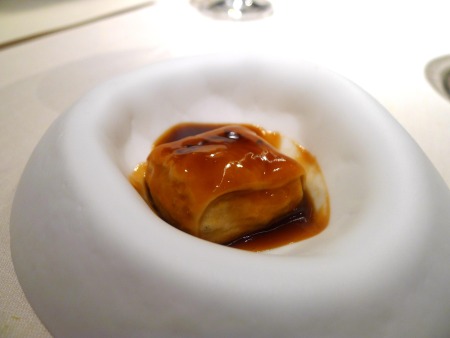
Ravioli of aromatic vegetables. Ravioli de vegetales aromáticos
Next came the pasta courses. A sort of traditional dining order is followed in VERY untraditional ways. The ravioli was like pasta of the earth, bursting with scratchy, green herbs.
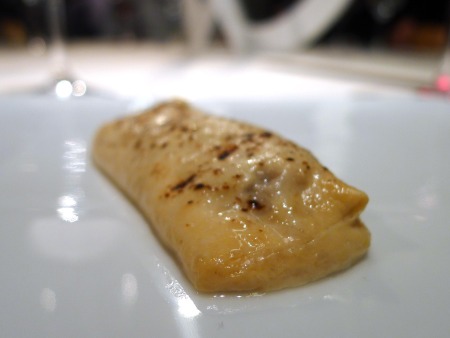
Lukewarm cannelloni of mollusc and milk. Canelón tibio de leche tostada y moluscos.
The cannelloni was like pasta of the sea, ours fragrant with huge clams.

Hazelnut and beans stew. Potaje de avellanas con nácar.
If you look at the spanish of this plate, you might say, what is nácar? It doesn't make it to the English translation, but it's the pearl color of the flakes on top of these stewed nuts. Yes, stewed nuts, with the richest of broths, is what we're eating before the fish and meat courses.
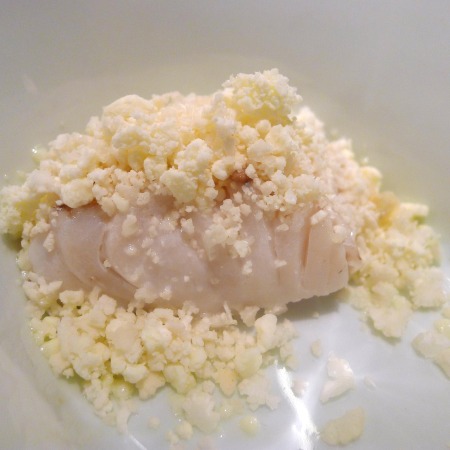
Roasted loin of hake with clashing grains of aged mascarpone, cauliflower and almonds. Merluza asada al horno con granos de coliflor, queso mascarpone y almendras.
This was an AWESOME dish. Besides the fact that the fish was incredible, some of the best I've ever had as far as being cooked to the perfect temp and texture, the plating was so surprising. Raw cauliflower and marscarpone that's been aged for nearly two weeks in china clay, salt and sugar (!). All the same size and color, similar textures, but with very different flavors.

Daily catch with acidic sprouts of amaranth and vanilla. Pescado de lonja con germinados sutiles de amaranto. Majado de hígados de pescado y vainilla.
Ours was grouper. Again, impeccable fish.
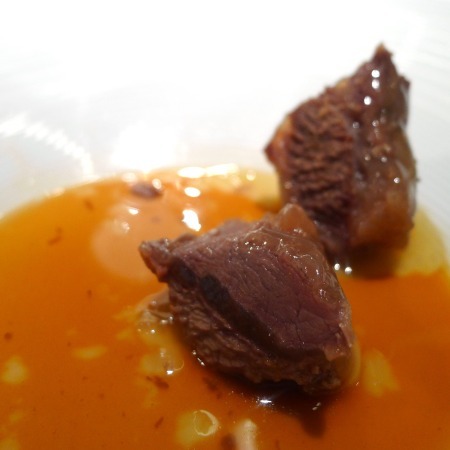
Beef cheek with glaze of its reduction and concentrated juice of grilled red peppers. Carrillera tostada con lágrimas de verdura asada.
Surprising to see carrilleras on a menu of this level. Carrilleras are the short ribs of Basque country, but they're so ubiquituous on pintxo bar menus that it surprised me to see it on the menu here. Nevertheless, delicious.
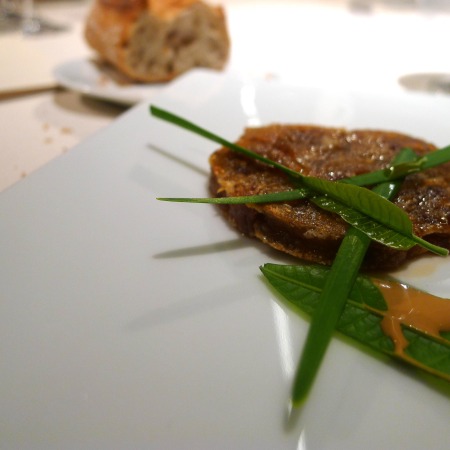
Crunchy terrine of Iberian pig tails with a bunch of bitter leaves and wine sediments. Terrina tostada de rabitos de cerdo ibérico. Manojo de hierbas y lías de vino.
Loved this one. Rich, crispy pig tail. But what really made me smile was tasting the sauce. Made from the lees of txakoli, it was DISGUSTING. But then something happened when I dipped the rich meat in it and tried the two together. Something delicious. THIS is why we need chefs in the world, people.
Then, on to the desserts. What an agreeable experience. It's as if, during menu planning in the upstairs office, they said: you know what? Let's forgo all the nonsense that generally pervades Spanish michelin star desserts and serve three simple plates. No flash. No flair.
Well...unless you consider a faux napkin, which I've been told takes days to make, flashy.
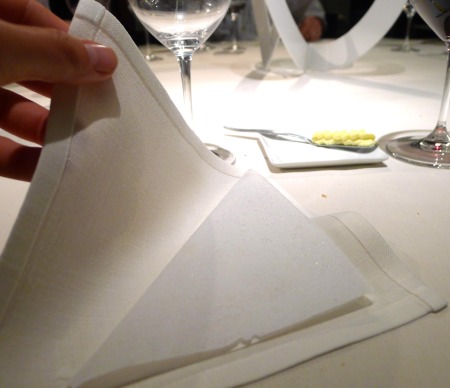
A taste of subtlety. Folded linen with toasted crème fraiche and crème caramel. Lienzo plegado. Crema de leche agria y dulce de caramelo.
A parallel to the manner in which we opened the meal. Nice.

“Forgotten memory from childhood.” Small bite of milky wafer with lemon ice cream. Regresando a la infancia: Barquillo de leche tostada con helado de limón.
Here worth noting was the plate. It was the typical grandma's decorated and colored glass, truly nostalgic and perfectly evocative of both the past and the lemony ice cream.
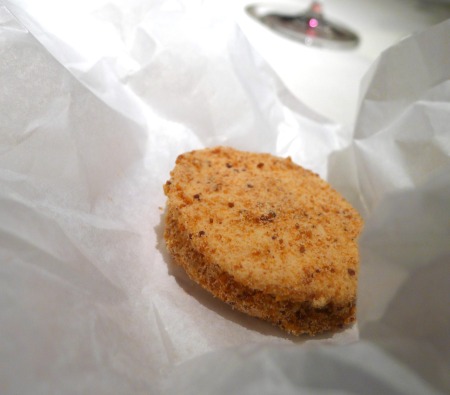
“Traditional” almond Fairy cake. Mantecado helado de almendras.
And there you have it.
Once again, Mugaritz was exactly what I would hope for in a restaurant of its caliber in its location. It speaks so much of Basque cuisine and products. You can TELL where you are, with your eyes closed. And it shows a simplicity and restraint that I really, really appreciate.
In fact, I feel such an appreciation that I've joined this group, which I recently discovered was created by my bestest bossest friends. Go Andoni!
Thank you so much to the Simon family for inviting me on this very special meal. And thanks to my friends at Mugaritz who made this meal so special.
*****
“Satiation eludes bread and olives...” Bromas y aceitunas, pocas o ninguna.
Crunchy sauce with citron and peppers. Salsa crujiente con cidra y pimientas.
Flax and wheat “Kraft” paper with roe and Arrow-grass buttons. Papel “Kraft” de lino y trigo con huevas de besugo y semillas de junco marino.
Grilled toast of bone marrow with herbs and horseradish ash. Tosta con tuétano asado, hierbas y cenizas de rábano.
The belly button of a monk...Blue cheese and black pudding Macaron. Macaron "ombligo de monje".
Tempered white asparagus and chrysanthemum petals. Esparrago blanco sobre un gel de mariscos tostados y brotes de "alga de tierra".
Stimulating insipidity: crunchy morsel of salted roe. Huevas de besugo con guisantes lagrimas.
Slices of foie-gras cured in clay and Sichuan peppercorns. Bath of apple extract. Láminas de fuagrás curado en arcilla y pimientas de Sechuan, bañadas con un extracto de manzana.
Grapes of melon and spiced seeds. Uvas de melón con pepitas especiadas.
Lukewarm cannelloni of mollusc and milk. Canelón tibio de leche tostada y moluscos.
Ravioli of aromatic vegetables. Ravioli de vegetales aromáticos
Hazelnut and beans stew. Potaje de avellanas con nácar.
Roasted loin of hake with clashing grains of aged mascarpone, cauliflower and almonds. Merluza asada al horno con granos de coliflor, queso mascarpone y almendras.
Daily catch with acidic sprouts of amaranth and vanilla. Pescado de lonja con germinados sutiles de amaranto. Majado de hígados de pescado y vainilla.
Beef cheek with glaze of its reduction and concentrated juice of grilled red peppers. Carrillera tostada con lágrimas de verdura asada.
Crunchy terrine of Iberian pig tails with a bunch of bitter leaves and red wine sediments. Terrina tostada de rabitos de cerdo ibérico. Manojo de hierbas y lías de vino tinto.
A taste of subtlety. Folded linen with toasted crème fraiche and crème caramel. Lienzo plegado. Crema de leche agria y dulce de caramelo.
“Forgotten memory from childhood.” Small bite of milky wafer with lemon ice cream. Regresando a la infancia: Barquillo de leche tostada con helado de limón.
“Traditional” almond Fairy cake. Mantecado helado de almendras.
